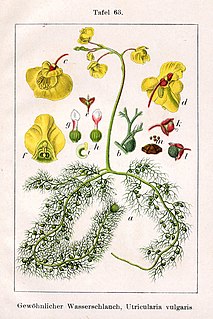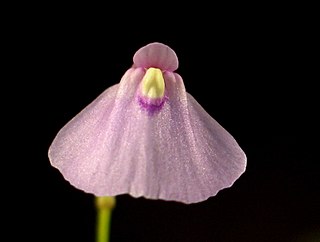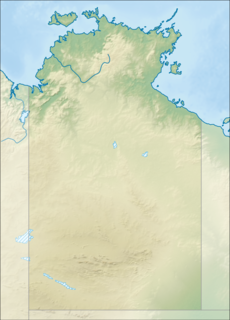
Utricularia, commonly and collectively called the bladderworts, is a genus of carnivorous plants consisting of approximately 233 species. They occur in fresh water and wet soil as terrestrial or aquatic species across every continent except Antarctica. Utricularia are cultivated for their flowers, which are often compared with those of snapdragons and orchids, especially amongst carnivorous plant enthusiasts.

Utricularia dichotoma, commonly known as fairy aprons, is a variable, perennial species of terrestrial bladderwort. The specific epithet is Latin for "dividing into pairs" and refers to the double arrangement of flowers which this species often displays.
Utricularia arnhemica is an affixed aquatic or terrestrial carnivorous plant that belongs to the genus Utricularia. It is endemic to the Arnhem Land area in the Northern Territory of Australia.
Utricularia dunlopii is an annual terrestrial carnivorous plant that belongs to the genus Utricularia. Its distribution ranges from Western Australia to the Northern Territory.
Utricularia dunstaniae is an annual terrestrial carnivorous plant that belongs to the genus Utricularia. Its distribution ranges from northern Western Australia to the Northern Territory.
Utricularia kimberleyensis, the Kimberley bladderwort, is a terrestrial carnivorous plant that belongs to the genus Utricularia. Its distribution ranges from the Dampier Peninsula in northern Western Australia to the area around Darwin in the Northern Territory.
Utricularia lasiocaulis is an annual terrestrial carnivorous plant that belongs to the genus Utricularia. Its distribution ranges from Western Australia through the Northern Territory and into Queensland, Australia.
Utricularia leptorhyncha is an annual, terrestrial carnivorous plant that belongs to the genus Utricularia. Its distribution ranges from Western Australia to the Northern Territory.
Utricularia rhododactylos is an annual carnivorous plant that belongs to the genus Utricularia. It is a terrestrial or affixed subaquatic species. It is endemic to the Northern Territory in Australia.
Utricularia tubulata is a suspended aquatic carnivorous plant that belongs to the genus Utricularia. Its distribution ranges across northern Australia from Western Australia through the Northern Territory and into Queensland.
Utricularia leptoplectra is a terrestrial or subaquatic carnivorous plant that belongs to the genus Utricularia. It is endemic to Australia with a distribution in the Northern Territory from the area around Darwin, east to the Arnhem Land plateau, south to Katherine, and west to the western Kimberley region in Western Australia.
Utricularia limosa is a terrestrial or subaquatic carnivorous plant that belongs to the genus Utricularia. It is endemic to Australia and Southeast Asia with distributions in China, Laos, Malaysia, New Guinea, the Northern Territory, Queensland, Thailand, Vietnam, and Western Australia.

Utricularia fulva is a small to medium-sized annual carnivorous plant that belongs to the genus Utricularia. U. fulva is endemic to Australia, where it appears to be largely restricted to the Northern Territory, specifically the Arnhem Land sandstone escarpment. It grows as a terrestrial or subaquatic plant in or near sandy stream beds. It was originally described and published by Ferdinand von Mueller in 1858.
Utricularia simmonsii is a small annual or perennial terrestrial carnivorous plant that belongs to the genus Utricularia and is the only member of Utricularia sect. Minutae. U. simmonsii is endemic to Australia and is only known from a few locations in the Northern Territory and Queensland. It and the section Minutae were originally published and described by Allen Lowrie, Ian D. Cowie, and John Godfrey Conran in 2008. It was named in honor of Paul Simmons, who discovered the species in Queensland in 2005.
Utricularia odorata is a medium-sized, probably perennial carnivorous plant that belongs to the genus Utricularia. It is native to southeastern Asia and northern Australia. U. odorata grows as a terrestrial plant in wet grasslands at low altitudes. It was originally described by François Pellegrin in 1920. The specific epithet odorata is derived from reports that the flowers are fragrant.

The Journal of Insectivorous Plant Society is a quarterly Japanese-language periodical and the official publication of the Insectivorous Plant Society of Japan. The journal was established in January 1950. As of 2010, it was published in A4 format and totals around 120 pages annually. The English title has been used alongside the original Japanese one from the April 1986 issue onwards.

Shoal Bay is a shallow bay lying adjacent to, and north of, the city of Darwin in the Northern Territory of Australia. Encompassing Hope Inlet at its eastern end, it is characterised by extensive areas of intertidal mudflats and mangroves and is an important site for waders, or shorebirds. The bay is situated within the Shoal Bay Coastal Reserve, a protected area that was established in 2000.

Shoal Bay Coastal Reserve is a protected area in the Northern Territory of Australia.

The North American Continent is home to a wide variety of carnivorous plant species. Species from seven genera are native to the continent, and three of these genera are found nowhere else on the planet.





